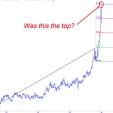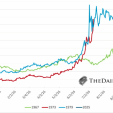Stock Market Bubble vs. Impressive Bullish Breakout
Fed-Induced Mania or Massive Underperformance?
The Federal Reserve has injected billions of dollars of freshly printed money into the global financial system via quantitative easing (QE). If you understand how QE works in the real world, it is difficult to overstate the role it has played in juicing the stock market, which is the basis for the bubble argument. The bullish breakout/massive underperformance argument is based on the long-term chart of the S&P 500 below.

In the chart above, the stock market went nowhere between point A in 1999 and point B in 2013. In isolation, if you were told the stock market made no progress over a 13-year period that does not sound like a bubble. In fact, it sounds like a period of massive underperformance. The green arrow above shows the recent breakout from a 13-year consolidation period in the S&P 500. The two video segments below take the bubble vs. breakout debate a little further. After viewing the clips, you can decide for yourself.
- This video clip covers the stock market’s performance over the past six and thirteen years, placing it in historical context.
- This clip covers the concepts of consolidation (indecision), fractals, and breakouts, which tell us to keep bullish scenarios on our 2013 probability radar.
Fed Has No Exit Strategy

The always sentimental Marc Faber recently made some very valid points relative to the Fed’s money printing and bond buying program. FromCNBC/Yahoo:
Faber has been predicting so-called “QE infinity” because “every government program that is introduced under urgency and as a temporary measure is always permanent.” He also said, “The Fed has boxed itself into a position where there is no exit strategy.”
Shutdown Pushes Tapering To 2014
The recent political theater in Washington may have given the Fed a reason (excuse if you are so inclined) to continue to print money. From CNBC:
The legacy of the recent government shutdown may well be that it got the Federal Reserve off the hook from pulling back on its stimulus at least through the rest of the year. In addition to the other headaches it caused, the shutdown is likely to make the next few months’ economic data unreliable enough that the central bank won’t be able to start pulling back on its $85 billion a month bond-buying program, according to several economists. “They’re going to approach each of the economic reports—no matter what the reports are representing in terms of data—ith a healthy dose of caution, and that is the right approach,” said Tom Porcelli, chief U.S. economist at RBC Capital Markets. “Tapering is off the table for this year. It’s becoming more of a 2014 event.”
Bond Bid Can Help Stocks
One of the Fed’s biggest fears is an economically-damaging spike in interest rates. When taper talk spooked bond investors, interest rates rose at an uncomfortable pace for those seeking to borrow money. If the Fed pushes tapering out to 2014, their QE funds will create demand for Treasuries, which has spillover effects for the economy and stock market. From CNBC:
The dollar was off Thursday, while the price of gold surged. Gundlach said that was an indication of lingering economic concern about the polarization in Washington. He also noted the Chinese downgrade of U.S. debt and the ongoing concern that U.S. ratings agency will drop Treasury debt because of the budget fights in Congress. Gundlach said there was no reason to believe short-term interest will rise in the foreseeable future, making bonds an attractive investment. With quantitative easing likely to extend well into 2014, Gundlach said he expects to see money coming back into the bond market over the next few months. “There’s no negative pressure on interest rates,” Gundlach said, citing the lack of inflation.

Who Is Buying Stocks?
When investors keep hearing “new all time highs” on the evening news, they are much more inclined to invest idle cash. This has been a source of demand for stocks and has helped push prices higher. Traders, who can move to 100% cash, often forget that is not an option for many market participants. In fact, pension funds tend to remain fully invested all the time, which makes monitoring demand flows important. FromBloomberg:
Money has been flowing in and out of financial markets more rapidly than ever before this year, a bullish signal as the threat of a U.S. government default fades. About $47 billion has gone to exchange-traded funds that track everything from stocks to
bonds to commodities since Sept. 1, according to data compiled by Bloomberg. That followed about $18 billion pulled in August, $40 billion added in July and $11 billion pulled in June, making it the most volatile period on record for flows. Almost $7 billion went to ETFs on Oct. 17 alone, as Congress passed legislation to avoid a default. Resolution of the budget impasse sends an all-clear signal that will spur another round of deposits, according to David Kelly, the chief global strategist at JPMorgan Funds in New York, which oversees about $400 billion in long-term assets. “The pattern we’d seen with flows for much of 2013 is going to resume now that things have settled down,” Kelly said by phone Oct. 17. “It’s a realization that the markets have been able to survive Washington.”
Housing Data Supports Taper Later
If the Fed is looking for another reason to keep the printing presses running at full capacity, the housing market’s reaction to tapering has been less than positive. The chart below shows demand for housing stocks has dropped off significantly since the Fed started taper talk in late May.

Monday’s data on existing home sales was not particularly surprising given the recent spike in interest rates. The Fed knows housing plays a very important role in the economy. From Reuters:
U.S. home resales fell in September and prices cooled as higher mortgage rates took the edge off the housing market recovery. The National Association of Realtors said on Monday that sales of previously owned homes fell 1.9 percent last month to an annual rate of 5.29 million units. At the same time, the median price rose 11.7 percent in September from a year ago to $199,200. While that was the 10th straight month of double-digit gains, it was the smallest increase since April.”This softening had been expected in response to the increase in mortgage rates that began in May,” said Daniel Silver, an economist at JPMorgan in New York.
Investment Implications
As we noted last Friday, one of the keys to success is to remain highly flexible. The S&P 500 has reached the top of a bullish trend channel that may attract some sellers.

There is a reason we refer to resistance as “possible resistance”. As shown in the chart of the broader NYSE Composite Index below, the upper trendline did not attract sellers, which means keeping an open mind about the S&P 500’s next move is prudent.

The supply and demand balance on the ETF front continues to point to many of our holdings as being prudent risk-reward options: broad U.S. (VTI), technology (QQQ), small cap (IJR), foreign developed (EFA), financials (XLF) and emerging markets (EEM). The table below shows recent relative demand scores (scale 0-100) for numerous ETFs that can provide some insight into the battle between economic confidence and economic fear. The results still support a risk-on investment allocation. With asset prices skewed by the Fed’s printing press and a possible scare from earnings season, we will continue to keep a flexible and open mind.

This entry was posted on Monday, October 21st, 2013 at 4:45 pm and is filed under Stocks - U.S.. You can follow any responses to this entry through the RSS 2.0 feed. Both comments and pings are currently closed.

















